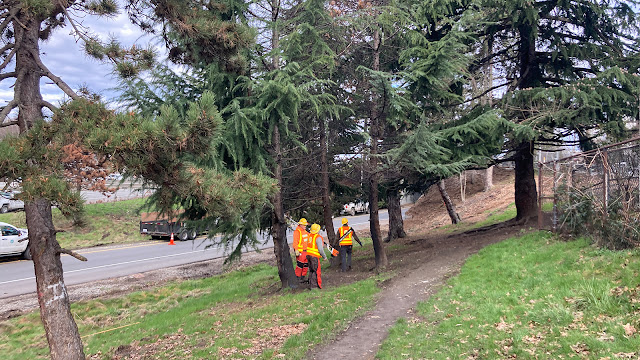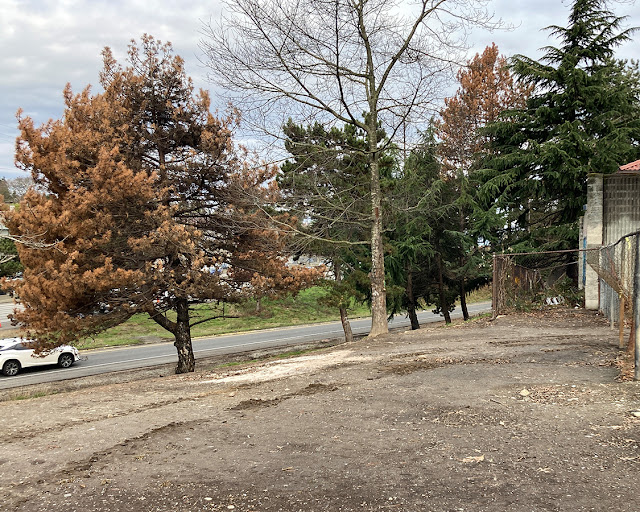By Aisha Dayal
When our maintenance crews were working along Interstate 5 in north Seattle, they noticed something on several nearby trees – something unusual, something different. The crews weren't sure what this meant, but they knew that someone needed to be notified, someone that was an expert.
An arborist team dedicated to tree risk and health care
 |
| A member of the arborist team training two crew members on proper pruning for healthy trees to be protected at the site near Interstate 5 in north Seattle. |
The experts are the arborist team within the Northwest Region's landscape architecture office. This specialized group includes Hailey Mak Mackay, Joe Sutton-Holcomb and Taylor McNeill. The goal of the team is to preserve, maintain, and manage trees on state right-of-way. For example, they work with our maintenance crews to assess and manage trees with health or structural issues near state roads. They also work with real estate services to assess trees near adjacent private and municipal property. Within the Landscape Architecture Office, they work with designers to protect trees from construction impacts associated with our road maintenance and improvement projects.
This team investigated what our maintenance crews observed on I-5 around Northeast 45th Street in Seattle. Researching the local area, they found these trees had been infested by bark beetles.
The team worked with the Department of Natural Resources to determine the species of bark beetle likely responsible – Ips paraconfusus. Then, they conducted a field survey to determine the level and area of infestation.
Unfortunately, treatment of the infested trees is not effective. The best chance to control the spread of the beetle is to remove the affected trees. This helps reduce the beetle populations and limit the spread to nearby healthy trees. So, by removing some these sick trees now, we have the best chance of protecting the remaining trees from beetle attacks.
We need to remove those infested trees during the second and third weeks of May, which will require overnight lane and ramp closures. Here's what that looks like:
First Closure: May 13-16, nightly 9 p.m. to 4 a.m.
- Northbound I-5 off-ramp to NE 85th St.
- NE 70th St. on-ramp to northbound I-5.
Second Closure: May 16-17, 9 p.m. to 4 a.m.
- Northbound I-5, right lane from NE 42nd St. to just south of NE 50th St.
Third Closure: May 20-23, nightly 9 p.m. to 4 a.m.
- Northbound I-5 off-ramp to NE 85th St.
Fourth Closure: May 23-24, 9 p.m. to 4 a.m.
- Northbound I-5, right lane from NE 42nd St. to just south of NE 50th St.
 |
| A maintenance truck is parked along northbound Interstate 5 in north Seattle with bark beetle infested trees nearby. |
How to spot an infested tree and why it happens
The most common look of a tree infested by bark beetles is when it starts to turn orange. Once infested, nearby and adjacent trees are also at risk. Managing an infestation requires removing dead trees and even some healthy neighboring ones, as we are doing at the end of May.
Bark beetle infestations don't just happen out of nowhere; infested trees are a secondary symptom. Often, the primary and most likely cause is drought. Trees can also be stressed by chronic factors including climate change, hotter and drier summers, fires, soil composition and pollution. When trees are stressed their immune systems are weaker. That makes it harder for them to repel swarms of the beetles. This can also leave nearby healthy trees more vulnerable.
 |
| A view of the state right of way showing a site where there are several trees infested with bark beetles that will need to be removed. |
The affected trees that we must remove were planted in the 1960s to give vibrancy along the interstate. The goal is always to preserve trees in the long run and maintain the canopy along highways. Experts have determined that 126 trees need to be removed in the north Seattle area. Most of these are along northbound I-5 near Northeast 45th and 50th Streets, Northeast 80th Street, and State Route 522 (also known as Lake City Way Northeast).
What can we see in the future?
This is a chance to establish more diverse and resilient roadside canopy on the I-5 corridor in north Seattle. Landscape architects and arborist specialists are developing a replanting and restoration plan for the area. Our team is looking at different options, keeping in mind the outlook and longevity for the new trees. The kind of trees will depend on the specific area. In general, the replacement species will include a diverse mix of evergreen and deciduous trees. Trees will be selected for environmental resilience and resistance to common pests and diseases. The team is also considering attributes such as cultural significance, pollinator habitat, and aesthetics. The possibility of cherry trees in the 45th and 50th street interchanges have also been discussed to align with the famed cherry trees on the nearby University of Washington campus.
Replanting will likely happen in fall and winter of 2024 and 2025, depending on the life cycle of each kind of tree and the optimal time to plant. Our arborists remind you that replanting the trees can be a long and involved process. Removing a damaged tree and replacing it with a new one doesn't mean that it'll look exactly like it did before. Remember, these existing trees were planted in the 1960s and it will take time for them to fully grow to the size we currently see along I-5.
With several teams and experts working to improve the health of the natural world around us, we can see the landscape of I-5 in north Seattle morph into new and exciting things to come, stay tuned!
So sad. Thank you for taking care of the trees. Hopefully the new ones can survive and keep this area beautiful and environmently healthy.
ReplyDelete